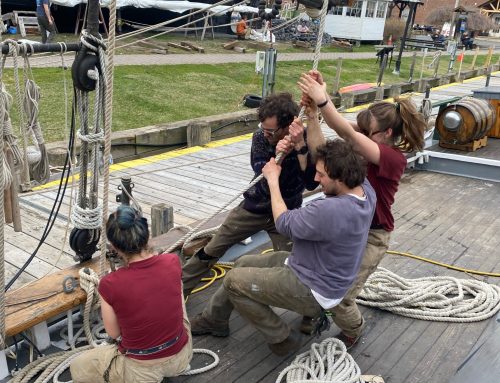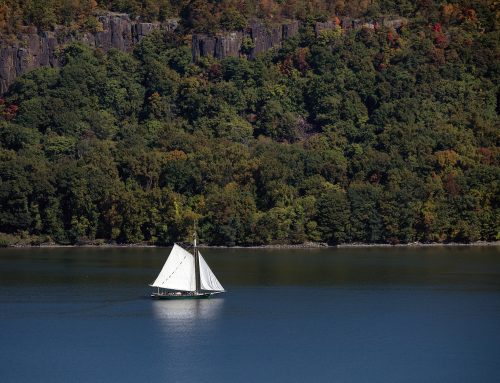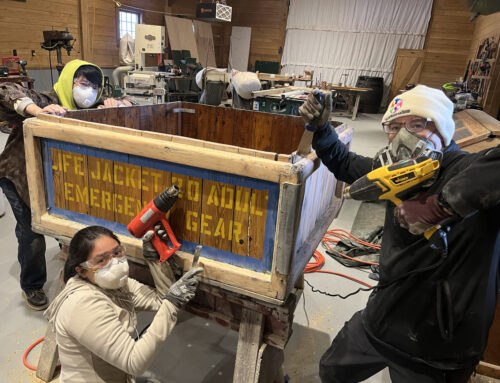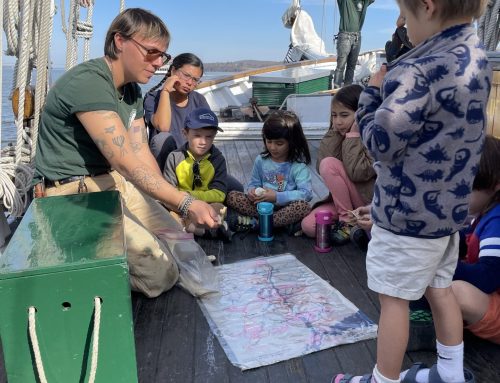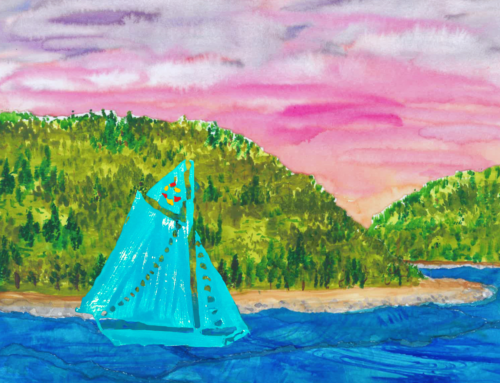Skip to content
Blue Connections
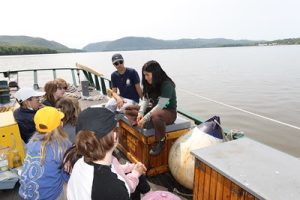
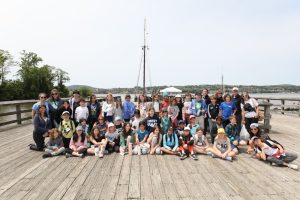
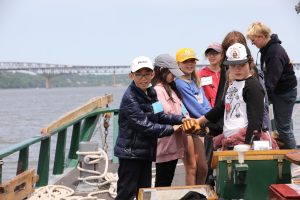
Thanks to funding from the Catskill Watershed Corporation, we were able to launch the first of what will hopefully be many years of the Blue Connections program. The goal of Blue Connections was to expand the pool of environmentally aware youth who live in the West of Hudson Watershed and NYC communities by bringing together students from both places on an education sail on the Hudson River. Through Blue Connections, which included several pre-trip virtual components in addition to the sail itself, the aim was that students would leave their Clearwater experience with an increased knowledge of, connection to, and appreciation for the West of Hudson Watershed, how New York City gets its drinking water, and the importance of protecting our watersheds.
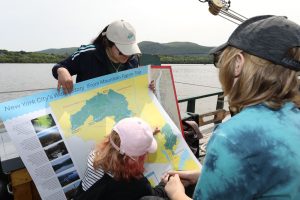 We are excited to report that we feel as though we met these goals. With invaluable collaboration with our partners at the Department of Environmental Protection (DEP), we facilitated 3 virtual lessons with the NYC and WOH schools, had students become pen pals with each other, and took everyone on a sail out of the dock in Beacon. Students demonstrated an understanding of watershed concepts, how NYC gets its drinking water, and water conservation. Students and teachers enjoyed the program and teachers from both schools expressed interest in participating in Blue Connections next year.
We are excited to report that we feel as though we met these goals. With invaluable collaboration with our partners at the Department of Environmental Protection (DEP), we facilitated 3 virtual lessons with the NYC and WOH schools, had students become pen pals with each other, and took everyone on a sail out of the dock in Beacon. Students demonstrated an understanding of watershed concepts, how NYC gets its drinking water, and water conservation. Students and teachers enjoyed the program and teachers from both schools expressed interest in participating in Blue Connections next year.
Woodstock Day School 4th and 5th graders and 4th and 5th graders from PS 199M’s Sustainability Club participated in Blue Connections. Between the two schools, we reached 40 students and 10 teachers and chaperones. Additionally, 8 crew members were trained on a curriculum that was adapted to cover watershed concepts. In total, we reached 58 people through the Blue Connections program directly. Indirectly, it is likely that we reached even more people, considering that many students probably went home and told family members and friends about their experience.
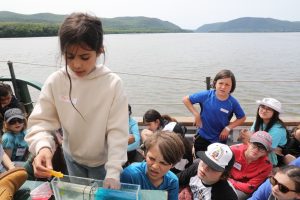
Each group participated in 2 virtual programs over Zoom before their sail. Together with the DEP’s Director of Education Robin Sanchez, Clearwater first delivered a virtual pre-sail lesson to each class separately that centered around the DEP’s From the Mountain Top to Tap curriculum. This lesson introduced students to the story of how drinking water gets from the WOH watershed to NYC, the history of this story, and how we are connected through water. This was also an opportunity to introduce the two organizations to the participating students.
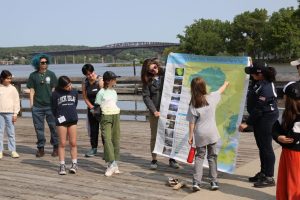 After the first virtual lesson with each group of students, students were paired with each other as Pen Pals. In between the first and second virtual lessons, students wrote to each other, introducing themselves and reflecting on water-related questions, including “Why is it important to learn about water?” “What are some examples of how someone might waste water?” “What are some ways you can waste less water?” “What is something you can do to help keep water clean?”
After the first virtual lesson with each group of students, students were paired with each other as Pen Pals. In between the first and second virtual lessons, students wrote to each other, introducing themselves and reflecting on water-related questions, including “Why is it important to learn about water?” “What are some examples of how someone might waste water?” “What are some ways you can waste less water?” “What is something you can do to help keep water clean?”
We then facilitated a second Zoom program where both schools were present. Here, students got to meet each other virtually and go through what to expect on their sailing field trip.
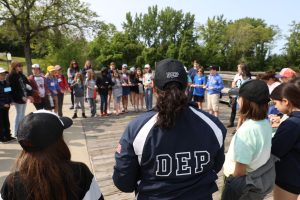 The program culminated with their sailing field trip out of Beacon, NY, which is about halfway between PS 199M and Woodstock Day School. Before going onboard, Robin led an icebreaker and students got to meet their Pen Pals in person. Once students boarded the Clearwater, they worked together to go fishing and raise our 3,000lb sail. In small groups, they rotated through hands-on stations where they explored more deeply many watershed concepts that they had previously learned about over Zoom. In our Navigation station, they compared and contrasted the From Mountaintop to Tap map with our ship’s navigation chart.
The program culminated with their sailing field trip out of Beacon, NY, which is about halfway between PS 199M and Woodstock Day School. Before going onboard, Robin led an icebreaker and students got to meet their Pen Pals in person. Once students boarded the Clearwater, they worked together to go fishing and raise our 3,000lb sail. In small groups, they rotated through hands-on stations where they explored more deeply many watershed concepts that they had previously learned about over Zoom. In our Navigation station, they compared and contrasted the From Mountaintop to Tap map with our ship’s navigation chart. 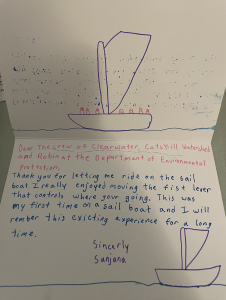 They got to compare the water quality of the Hudson River to the quality of the drinking water at their respective schools by conducting water chemistry tests. At our Fish station, students engaged with fish and other river creatures and discussed how actions they can take to protect the Hudson River ecosystem can apply in their home communities. They also discussed how we can learn from Indigenous practices to be better stewards of our environment in our Indigenous Peoples station.
They got to compare the water quality of the Hudson River to the quality of the drinking water at their respective schools by conducting water chemistry tests. At our Fish station, students engaged with fish and other river creatures and discussed how actions they can take to protect the Hudson River ecosystem can apply in their home communities. They also discussed how we can learn from Indigenous practices to be better stewards of our environment in our Indigenous Peoples station.
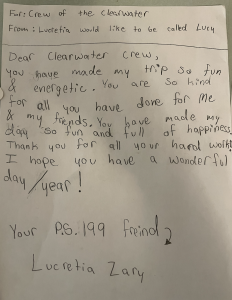 Surveys administered to the students at the end of their sail demonstrated an increased knowledge in watershed concepts. For example, 87% of students knew that drinking water travels to NYC through aqueducts. All students agreed that they felt connected to water resources. When asked, “What is something that you can do to conserve water?” students responded with a variety of solutions including taking shorter showers, turning off the water while brushing teeth, using only the amount of water that you need, and encouraging others in their lives to conserve water, as well. Lastly, 15% of students agreed a little that they had a great time with Clearwater and the DEP, and 80% agreed a lot.
Surveys administered to the students at the end of their sail demonstrated an increased knowledge in watershed concepts. For example, 87% of students knew that drinking water travels to NYC through aqueducts. All students agreed that they felt connected to water resources. When asked, “What is something that you can do to conserve water?” students responded with a variety of solutions including taking shorter showers, turning off the water while brushing teeth, using only the amount of water that you need, and encouraging others in their lives to conserve water, as well. Lastly, 15% of students agreed a little that they had a great time with Clearwater and the DEP, and 80% agreed a lot.
All in all, the first year of Blue Connections was a success. Once again, we’d like to thank the Catskill Watershed Corporation and the DEP for their support, which made this possible. We are already looking forward to next year and to connecting more students to their water resources!
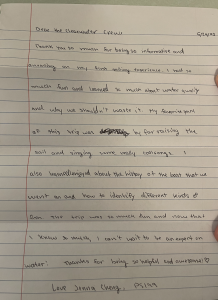
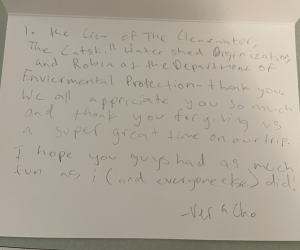
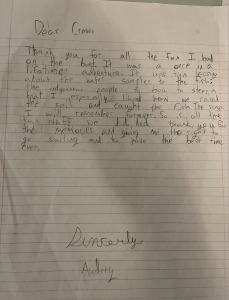
Share This Story, Choose Your Platform!
Page load link
 We are excited to report that we feel as though we met these goals. With invaluable collaboration with our partners at the Department of Environmental Protection (DEP), we facilitated 3 virtual lessons with the NYC and WOH schools, had students become pen pals with each other, and took everyone on a sail out of the dock in Beacon. Students demonstrated an understanding of watershed concepts, how NYC gets its drinking water, and water conservation. Students and teachers enjoyed the program and teachers from both schools expressed interest in participating in Blue Connections next year.
We are excited to report that we feel as though we met these goals. With invaluable collaboration with our partners at the Department of Environmental Protection (DEP), we facilitated 3 virtual lessons with the NYC and WOH schools, had students become pen pals with each other, and took everyone on a sail out of the dock in Beacon. Students demonstrated an understanding of watershed concepts, how NYC gets its drinking water, and water conservation. Students and teachers enjoyed the program and teachers from both schools expressed interest in participating in Blue Connections next year. After the first virtual lesson with each group of students, students were paired with each other as Pen Pals. In between the first and second virtual lessons, students wrote to each other, introducing themselves and reflecting on water-related questions, including “Why is it important to learn about water?” “What are some examples of how someone might waste water?” “What are some ways you can waste less water?” “What is something you can do to help keep water clean?”
After the first virtual lesson with each group of students, students were paired with each other as Pen Pals. In between the first and second virtual lessons, students wrote to each other, introducing themselves and reflecting on water-related questions, including “Why is it important to learn about water?” “What are some examples of how someone might waste water?” “What are some ways you can waste less water?” “What is something you can do to help keep water clean?” The program culminated with their sailing field trip out of Beacon, NY, which is about halfway between PS 199M and Woodstock Day School. Before going onboard, Robin led an icebreaker and students got to meet their Pen Pals in person. Once students boarded the Clearwater, they worked together to go fishing and raise our 3,000lb sail. In small groups, they rotated through hands-on stations where they explored more deeply many watershed concepts that they had previously learned about over Zoom. In our Navigation station, they compared and contrasted the From Mountaintop to Tap map with our ship’s navigation chart.
The program culminated with their sailing field trip out of Beacon, NY, which is about halfway between PS 199M and Woodstock Day School. Before going onboard, Robin led an icebreaker and students got to meet their Pen Pals in person. Once students boarded the Clearwater, they worked together to go fishing and raise our 3,000lb sail. In small groups, they rotated through hands-on stations where they explored more deeply many watershed concepts that they had previously learned about over Zoom. In our Navigation station, they compared and contrasted the From Mountaintop to Tap map with our ship’s navigation chart.  They got to compare the water quality of the Hudson River to the quality of the drinking water at their respective schools by conducting water chemistry tests. At our Fish station, students engaged with fish and other river creatures and discussed how actions they can take to protect the Hudson River ecosystem can apply in their home communities. They also discussed how we can learn from Indigenous practices to be better stewards of our environment in our Indigenous Peoples station.
They got to compare the water quality of the Hudson River to the quality of the drinking water at their respective schools by conducting water chemistry tests. At our Fish station, students engaged with fish and other river creatures and discussed how actions they can take to protect the Hudson River ecosystem can apply in their home communities. They also discussed how we can learn from Indigenous practices to be better stewards of our environment in our Indigenous Peoples station.  Surveys administered to the students at the end of their sail demonstrated an increased knowledge in watershed concepts. For example, 87% of students knew that drinking water travels to NYC through aqueducts. All students agreed that they felt connected to water resources. When asked, “What is something that you can do to conserve water?” students responded with a variety of solutions including taking shorter showers, turning off the water while brushing teeth, using only the amount of water that you need, and encouraging others in their lives to conserve water, as well. Lastly, 15% of students agreed a little that they had a great time with Clearwater and the DEP, and 80% agreed a lot.
Surveys administered to the students at the end of their sail demonstrated an increased knowledge in watershed concepts. For example, 87% of students knew that drinking water travels to NYC through aqueducts. All students agreed that they felt connected to water resources. When asked, “What is something that you can do to conserve water?” students responded with a variety of solutions including taking shorter showers, turning off the water while brushing teeth, using only the amount of water that you need, and encouraging others in their lives to conserve water, as well. Lastly, 15% of students agreed a little that they had a great time with Clearwater and the DEP, and 80% agreed a lot.







